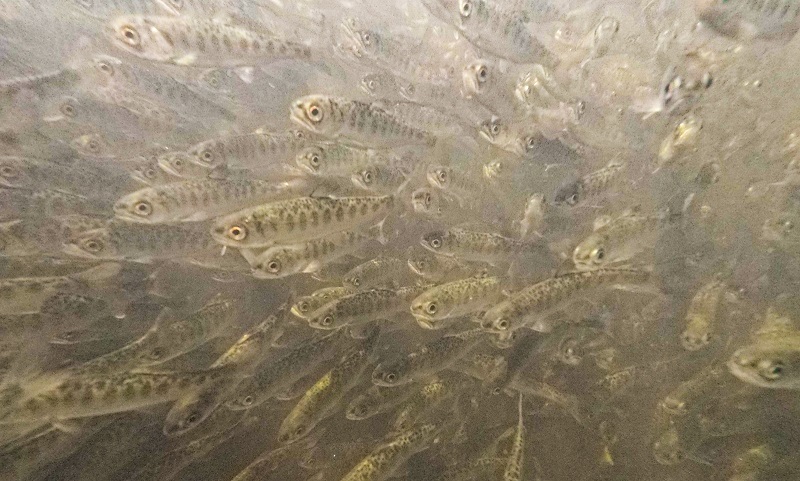Klamath River - Upper - CA Fish Report for 3-1-2024
Fall-Run Chinook Salmon Fry Succumb to Gas Bubble Disease in Klamath River
Klamath River - Upper - CA - Hornbrook, CA (Siskiyou County)

by Erin Loury, FISHBIO
3-1-2024
Website
The California Department of Fish and Wildlife (CDFW) announced today that fall-run Chinook salmon fry released for the first time from its Fall Creek Fish Hatchery in Siskiyou County are presumed to have succumbed to gas bubble disease in the Klamath River.
On Monday, Feb. 26, CDFW released approximately 830,000 fall-run Chinook salmon fry into Fall Creek, a tributary of the Klamath River above Iron Gate Dam. The fish were hatched at CDFW’s new, $35 million, state-of-the-art Fall Creek Fish Hatchery, which represents California’s long-term commitment to supporting and restoring both Chinook and coho salmon runs on an undammed Klamath River.
The salmon fry experienced a large mortality based on monitoring data downstream. Indications are the cause of mortality is gas bubble disease that likely occurred as the fry migrated though the Iron Gate Dam tunnel, old infrastructure that is targeted for removal along with the Iron Gate Dam itself later this year. Gas bubble disease results from environmental or physical trauma often associated with severe pressure change.
There is no indication the mortality is associated with other Klamath River water quality conditions such as turbidity and dissolved oxygen, which were reading at suitable levels on Feb. 26 and the days prior to release. The visual appearance of the dead fry detected by monitoring equipment points to gas bubble disease. Monitoring equipment documented other healthy yearling coho and Chinook salmon that came from downstream of the dam.
The problems associated with the Iron Gate Dam tunnel are temporary and yet another sad reminder of how the Klamath River dams have harmed salmon runs for generations. CDFW will plan all future salmon releases below Iron Gate Dam until this infrastructure is removed. Poor habitat conditions caused by the dams and other circumstances such as this are reasons why CDFW conducts releases of hatchery fish at various life stages.
CDFW’s Fall Creek Fish Hatchery continues to hold approximately 3.27 million healthy, fall-run Chinook salmon. Additional releases are planned later in the month.
The annual fall-run Chinook salmon production goal for the hatchery is to raise and release 3.25 million fish – 1.25 million released as fry, 1.75 million as smolts, and 250,000 as yearlings. The additional stock of fall-run Chinook salmon remaining in the hatchery exceeds the annual production goal and will help offset losses experienced with the initial release of fry.
FISHBIO is a dedicated group of research scientists, engineers, and technicians that specialize in counting, tracking, and analyzing trends in fish and wildlife populations throughout the world. An expert staff, technical capacity, and state-of-the-art equipment make FISHBIO a trailblazer in aquatic research. For more information, please visit FISHBIO.com.
< Previous Report
< Previous Report
More Reports
Salmon with a Side of Lamprey: Non-native Basses Primarily Eat Native Fishes in California's Stanislaus River
Stanislaus River
2-19-2024
Salmon face many perils during their migration to the ocean, including disease, entrainment, degraded water quality, and predation. However, predation...... Read More

1-30-2024
Appearing in evolutionary records as early as the icy Pleistocene epoch, Oncorhynchus kisutch – better known as coho or “silver salmon” – have swum...... Read More

Website Hosting and Design provided by TECK.net